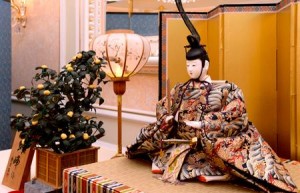 ASTANA – An exhibition, “Dolls of Japan,” was recently held at the Museum of the First President. Japanese children have made dolls throughout the history of the country and they have become known worldwide as part of the culture of Japan.
ASTANA – An exhibition, “Dolls of Japan,” was recently held at the Museum of the First President. Japanese children have made dolls throughout the history of the country and they have become known worldwide as part of the culture of Japan.
The exhibition presented dolls from the personal collection of the spouse of Ambassador of Japan to Kazakhstan Kamohara Masayoshi.
“Our dolls have an ancient history. They reflect traditions, customs and the art of the people. They were created in different regions of the country and are very popular today. We are glad of the opportunity to show them to Kazakh viewers,” said Masayoshi.
Japanese dolls are made of wood, paper, clay, textiles and even from living chrysanthemum. Some dolls are carefully stored and passed on from generation to generation. For example, at theHina Matsuri, the Festival of Dolls or Festival ofGirls, the dolls are given certain roles, such as the Emperor and Empress, court ladies, musicians, ministers, bodyguards and servants. Just as in modern sets for Barbie, Japanese doll sets often includeminiature furniture, carriages, chests and boxes.On the Festival of Boys, or Children’s Day, the Japanese fly multicolored flags in the form of carp fish on poles in front of their homes. The number of flags corresponds to the number of sons in the family. Carps are a symbol of resilience and courage because they are able to swim against a strong current. And the exhibited gogatsu-ningyo dolls represent samurai in armours.
Each doll has its own story, face and character. The viewer canadmire aristocratic ladies in elegant silk kimono, girls at the loom, girls with a musical instrument or umbrellas, warriors as if descended from the pages of heroic epics or gogatsu-ningyo – small figurines of charming chubby kids.
Hakata-ningyoare ceramic dolls, which were made in Fukuoka Prefecture in the early 17th century. Ancient masters had honed their skills for centuries, and one of the folk songs include the words,“When I come in Hakata, I’m alone, when I come back, I’m going with a doll.”
Indeed, dolls are the most coveted souvenir from the land of the rising sun. But the ornamental interior dolls are expensive and most of the tourists bring kokeshi, the favourite of Japanese girls, with a smiling face in dresses with colorful chrysanthemums.
One of the symbols of Japan is a figurine of a sitting cat with a raised front paw: it welcomes guests. Its name is Maneki-neko, which means“inviting cat” or “cat of happiness.” It is believed that if the cat raises its paw, good fortune will come to the family. That is why this figurine is seen around Japan.
Dolls in Japan enjoy love and respect. Since 1936, doll manufacturing has been officially recognised as an art. And since 1955, doll craftsman have been eligible for the honorary title, “Living National Treasure.” Dolls have even been devoted to the celebrated Japanese haiku.


